Updated November 12, 2024 Authored by Chris Cloney and Jon Barrett
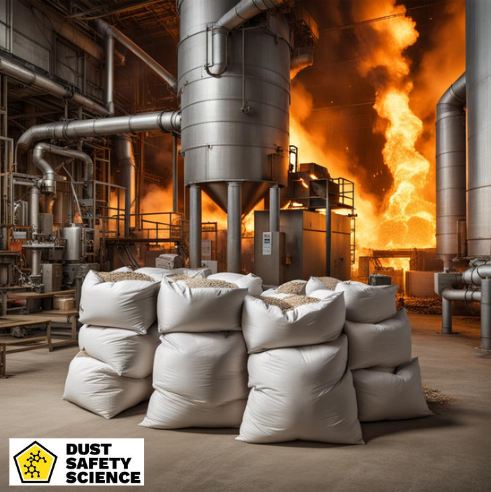
Key Takeaways:
- Effective Combustible Dust Control: Learn how to implement combustible dust cleaning solutions and dust collection with industrial vacuum systems, industrial vacuum cleaners, and combustible dust vacuum cleaners to enhance workplace safety and prevent hazardous incidents, during industrial manufacturing processes.
- Choosing the Right Vacuum: Explore a variety of strategies, classes, such as Class i, Class ii, and Class ii Division 2, and methods for the safe cleaning of combustible dust, when using explosion proof and certified, industrial vacuum systems and industrial vacuum cleaners.
- Compliance and Best Practices: Stay up-to-date with combustible dust vacuum cleaners, industrial vacuum systems, and vacuum cleaners, with industry compliance requirements, and discover best practices to maintain a combustible dust-free environment, promoting a secure and efficient workspace.
Table of Contents:
- Understanding Combustible Dust and Its Relevance in Industrial Settings
- Introduction to the Concept of a Combustible Dust Vacuum
- Combustible Dust and the Imperative for Specialized Vacuum Solutions
- The Dangers and Hazards of Using Shop-Style Vacuums, for Mitigating Combustible Dust
- The Dangers and Hazards of Using Commercial Vacuum Trucks, for Mitigating Combustible Dust
- The Dangers and Hazards of Using Ride-Along Floor Scrubbers, for Mitigating Combustible Dust
- The Dangers and Hazards of Using Compressed Air Hoses, for Mitigating Combustible Dust
- Safety Standards and Certifications, for Combustible Dust Vacuums
- Controlling Fugitive Combustible Dust with Specialized Vacuum Equipment
- Explosion Proof and ATEX rated Vacuum Systems, for Combustible Dust
- Best Practices for Using Combustible Dust Vacuums to Control Fugitive Dust
- Conclusion
Combustible Dust and Vacuum Cleaning
Combustible dust, when suspended in the atmosphere and ignited, can lead to a rapid release of energy, resulting in an explosion hazard and devastating explosions. Combustible dust refers to fine particles or dust generated from various materials like wood, metal, chemicals, or food that, when suspended in the air in the right concentration, can ignite and cause combustible dust explosions. These combustible particulate solids and particles are often a byproduct of manufacturing processes and industrial manufacturing processes and are highly prevalent in industries such as food processing, woodworking, pharmaceuticals, metalworking, and combustible metals.
A Dust Hazard Analysis , DHA, should be used as a first step, to safely assess whether your combustible dusts exists in your manufacturing facility, such as combustible metals. A DHA will prioritize safety to prevent potential dust explosions and a potential explosion hazard. When dealing with explosive environments, facility safety personnel should choose the right industrial vacuum systems and industrial vacuum cleaners, before cleaning combustible dust, to prevent any incidents. In addition, a certified, nationally recognized testing laboratory and proper certification to use the proper industrial vacuum cleaner and industrial vacuum system is extremely important, to choose the correct industrial vacuum cleaners.
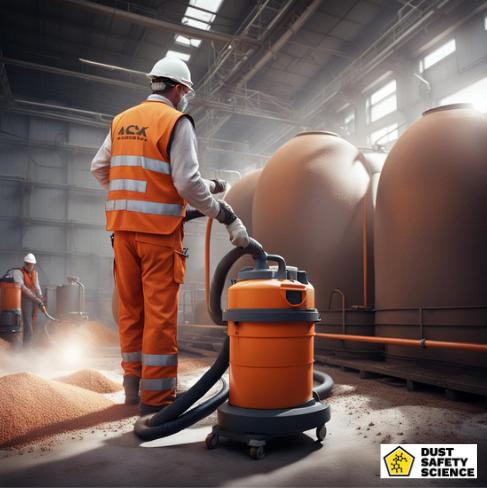
Using a Combustible Dust Vacuum Cleaner
In industries where combustible dust is generated, controlling its accumulation is critical to prevent a hazard and dust explosions, during industrial manufacturing processes in these hazardous locations. Regular cleaning is necessary, but using a conventional vacuum cleaner in such environments can lead to catastrophic consequences, due to the potential for sparks or E-electrostatic discharge that can ignite the combustible dust. Selecting the best combustible dust cleaning services is also a best practice and approach. OSHA-recommended housekeeping procedures include, but are not limited to:
1) Clean dust residues at regular intervals, using cleaning methods that do not generate dust clouds, if ignition sources are present (such as blow-down methods).
2) Only use combustible dust vacuum cleaners or a certified vacuum cleaner approved for dust collection.
3) Regularly clean floors and horizontal surfaces, such as ducts, pipes, hoods, ledges, and beams, with a certified, combustible dust vacuum cleaner, to minimize dust accumulations within operating areas of the facility, eliminating any dust accumulation.
4) Only use ATEX and UL Explosion Proof electrically powered cleaning devices, such as sweepers or industrial vacuum cleaners used in dusty areas, must be approved for the hazard classification, (example Class i).
Specialized Vacuum Solutions
Dust poses a significant risk in various industries, from manufacturing plants to food processing facilities. When suspended in the air, these fine particles can ignite under certain conditions, leading to explosions with devastating consequences. While cleaning up and dust collection of such dust might seem like a routine task, the use of regular vacuum cleaners for dust collection is not only insufficient but can also be highly dangerous. Combustible dust vacuum cleaners should be explosion proof industrial vacuums, and industrial vacuum systems, and a certain vacuum cleaner, need to be certified for hazardous environments.
- Inadequacy of Regular Vacuum Cleaners: Standard household, shop vacs, or commercial vacuum cleaners are designed for everyday cleaning tasks. However, they are not explosion proof, industrial vacuum cleaners and lack the specialized features necessary to handle combustible dust safely. Here’s why regular vacuums fall short:
- Ignition Risk: Regular vacuum cleaners are not equipped to prevent sparks or Electrostatic discharge during operation. When used on combustible dust, they can inadvertently create sparks or heat, triggering an explosion.
- Filter Systems: Most household vacuum cleaners do not possess filtration systems capable of capturing fine combustible particles adequately. These particles are incredibly small and can easily pass through standard filters on vacuum cleaners, allowing them to escape back into the air or accumulate within the vacuum cleaners, increasing the risk of a hazardous situation.
- Construction and Design: Regular vacuum cleaners often contain components that are not designed to prevent static discharge or withstand the potentially explosive nature of dust, making them inherently unsafe for such industrial vacuum systems environments.
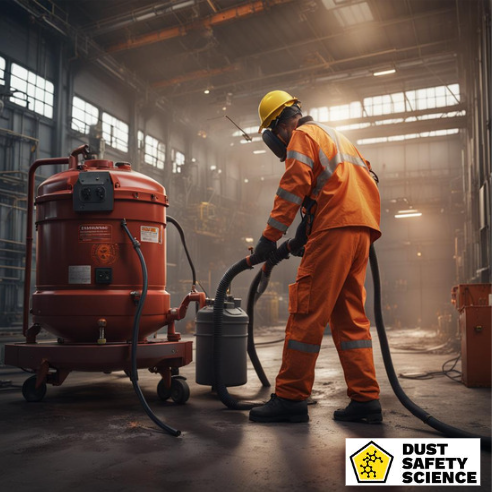
The Hazards of Shop-Style Vacuums
Using shop-style vacuums for cleaning combustible dust can pose severe catastrophic consequences and combustible dust explosion events. Dust, consisting of fine particles from materials like wood, metal, plastics, or chemicals, can ignite or explode when suspended in the air in certain concentrations. Health and safety managers will need to consult about the safety considerations of using shop-style vacuum cleaners for cleaning combustible dust including:
- Ignition and Explosion Risk: Combustible dust, when dispersed in the air, can ignite with a spark or heat source, and Electrostatic discharge. Using vacuums without appropriate explosion proof safety features can cause a combustible dust explosion, leading to severe injuries, property damage, or even fatalities.
- Equipment Overheating: Shop vacuums that aren’t designed for combustible dust might lack intrinsically safe features like moving parts, grounded hoses, conductive components, or explosion proof motor construction. This can lead to the vacuum electrical equipment overheating and becoming an ignition source when it comes in contact with dust.
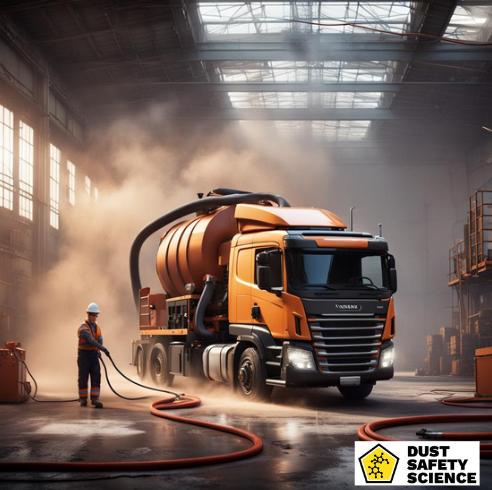
The Hazards of Commercial Vacuum Trucks
Health and safety managers will also need to consult about the safety considerations of using commercial vacuum trucks for cleaning combustible dust can present significant dangers and requires strict adherence to safety protocols to prevent potential hazards. Commercial Vacuum trucks for cleaning combustible dust may create several dangers:
- Explosion and Fire Hazard: Combustible dust, when suspended in the air in the right concentrations, can ignite with a spark or heat source. The powerful suction and airflow of commercial vacuum trucks can generate static, potentially causing ignition and leading to explosions or fires.
- Ignition Sources: Vacuum trucks typically have electrical components, engines, or mechanical parts that can produce sparks and Electrostatic discharge. In environments with dust, these sources can trigger explosions if not properly managed or if the vacuum truck is not designed to mitigate these risks.
- Dust Clouds and Concentration: The vacuuming process can create dust clouds, increasing the concentration of suspended particles in the air. If these concentrations reach explosive levels, any ignition source can trigger an explosion.
- Vacuum Hose Length and Safety Issues: Commercial vacuum trucks must be parked outside a Manufacturing Facility. As a result, extensive amounts of Vacuum hoses and extension cords pose a safety issue for trips and falls, and not intrinsically safe .
- Idling of Commercial Vacuum Trucks: Commercial vacuum trucks may need to idle, for extended periods, resulting in local air pollution from exhaust fumes, leaking flammable liquids, loud noise infractions per the OSHA Summary of the Noise Control Act, accidental dislodging of truck brakes, or accidental turning off of all power.
- Gasoline, Diesel, Oil, Coolant, Natural Gas, and Propane Safety: Commercial vacuum trucks may leak gasoline as flammable gas, diesel, Oil, transmission fluid, Coolant, Natural Gas, Propane or other flammable liquids into the direct project environment or outside the Manufacturing Facility.
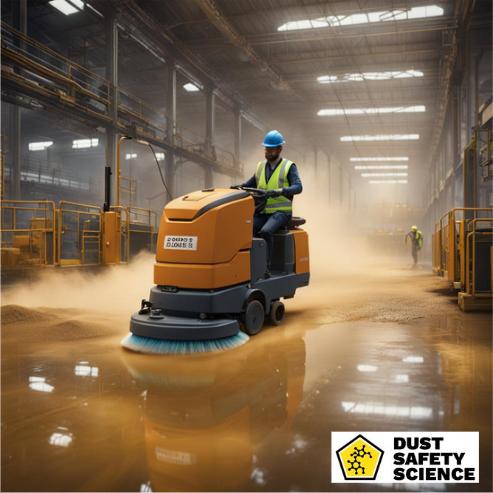
The Hazards of Ride-Along Floor Scrubbers
Using ride-along floor scrubbers for cleaning combustible dust can pose significant dangers and possible combustible dust explosions. These machines, designed for floor cleaning in various industrial settings, can inadvertently stir up dust, leading to potential hazards. Safety considerations when using ride-along floor scrubbers for dust cleaning include:
- Dust Suspension: Ride-along floor scrubbers can agitate and stir up settled dust particles during the cleaning process. This agitation from moving parts can cause the dust to become suspended in the air, increasing the risk of explosions or fires if ignited, in hazardous locations
- Ignition Sources: The floor scrubber’s moving parts, electrical components, and motors can generate sparks or heat, and Electrostatic discharge, which, in the presence of suspended dust, can act as an ignition sources leading to explosions. Also, using flammable gas, propane, or other flammable liquids may cause additional safety issues, and can be a fire or explosion hazard.
- Ineffective Cleaning: If the scrubber lacks appropriate dust containment systems or filtration, it may inadvertently spread the dust around or fail to capture it effectively, leading to incomplete cleaning and potential hazards, in hazardous locations
The Hazards of Compressed Air Hoses
Using compressed air hoses for cleaning combustible dust poses significant dangers, is not intrinsically safe, and can cause combustible dust explosions. Compressed air creates dust clouds, creating an environment prone to explosions or fires, and can also redistribute dust around the facility. Safety considerations when using air hoses for cleaning dust include:
- Dust Suspension: Air can easily disperse and suspend combustible dust particles in the air. When airborne, these particles can form explosive concentrations if ignited by a spark or heat source, in hazardous locations.
- Static Electricity: The high-speed flow of air through hoses can generate static. This static charge can accumulate on hoses and surfaces, potentially leading to static discharge and ignition of combustible dust.
- Ignition Sources: The use of air hoses can introduce multiple ignition sources, including electrical equipment, moving parts, or even friction from the high-pressure airflow, which can trigger explosions when in contact with combustible dust.
- Dust Redistribution: The use of air often just acts to redistribute combustible dust around the facility. In particular, air hoses can cause dust to settle at the highest level surfaces or hard-to-reach areas, which can be the most dangerous when a secondary dust explosion occurs.
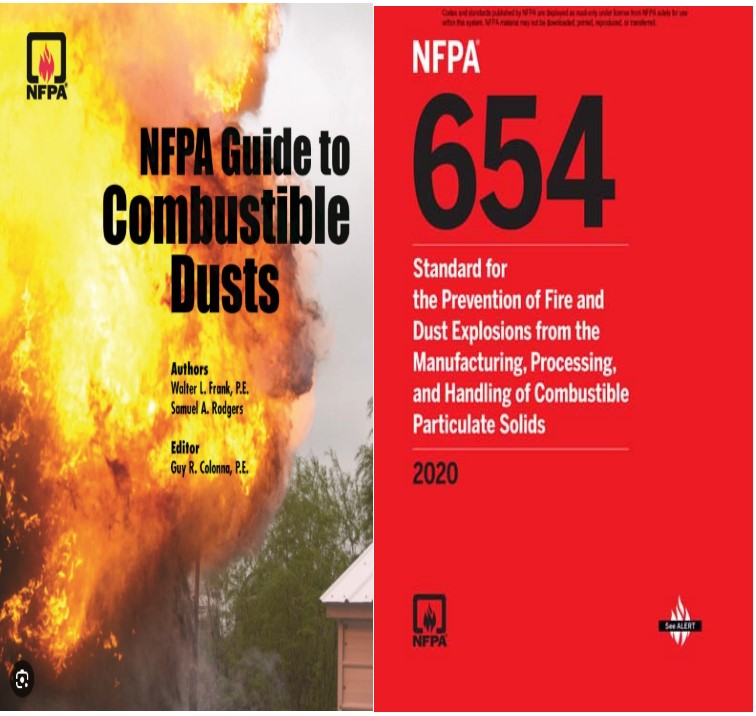
Safety Standards and Certifications
Safety standards such as the OSHA and NFPA standards and certifications are crucial for ensuring the proper design, manufacturing, and usage of dust vacuums to prevent potential hazards, and managing combustible dust fire threat, at the highest level of safety. Safety standards and certifications relevant to combustible dust vacuums include:
- NFPA (National Fire Protection Association) Standards:
NFPA 652: This National Fire Protection Association, NFPA 652 standard provides fundamental guidelines for managing combustible dust hazards across various industries. The NFPA 652 outlines principles for risk assessment, hazard identification, and safety measures, including the use of proper vacuum systems.
NFPA 654: This National Fire Protection Association, NFOA 654 standard specifically focusing on preventing fire and dust explosions, this standard addresses the design, construction, and maintenance of dust collection systems, including vacuums, in various industrial settings. Both of these NFPA standards are extremely beneficial.
NFPA 70: This National Fire Protection Association standard, NFPA 70, National Electrical Code (NEC) is the benchmark for safe electrical design, installation, and inspection to protect people and property from electrical hazards. All of these NFPA standards are extremely beneficial regarding industrial dust vacuums.
- OSHA (Occupational Safety and Health Administration):
OSHA Regulations: OSHA provides general guidelines and regulations for handling combustible dust in the workplace. Employers must comply with OSHA standards to ensure a safe working environment, including proper equipment usage and employee training.
- Combustible Dust National Emphasis Program (NEP): This program focuses on inspecting facilities that handle combustible dust to ensure compliance with OSHA regulations. It emphasizes the importance of proper vacuum systems to mitigate hazards.
- ATEX Directive (Atmosphères Explosibles):
ATEX Directive 2014/34/EU: Applicable in the European Union, this directive regulates equipment intended for use in potentially explosive atmospheres. It categorizes equipment into zones based on the risk of explosion and specifies safety requirements for vacuum systems used in such areas.
- UL (Underwriters Laboratories) Certification:
UL Standards: UL provides certifications and standards for electrical and safety features in equipment, including vacuum systems. UL listings ensure that the vacuum meets specific safety criteria and can be used safely in hazardous environments.
- CSA (Canadian Standards Association) Standards:
CSA Standards: Similar to UL, CSA provides safety certifications and standards for various equipment, including combustible dust vacuums, ensuring compliance with Canadian safety requirements.
These standards and certifications aim to mitigate the risks associated with combustible dust by setting guidelines for equipment design, construction, and usage. An Internal safety administration should ensure the vacuum setup is compliant with OSHA and NFPA standards.
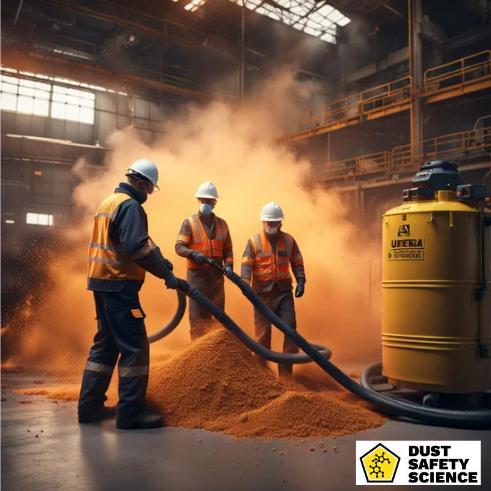
Controlling Fugitive Combustible Dust
- Preventing Airborne Dispersal: Combustible dust vacuums are specifically designed to capture and contain fugitive dust particles without dispersing them back into the air. Their high-efficiency filtration systems, such as HEPA filters, ensure that even the tiniest combustible dust particles are trapped and retained within the vacuum.
- Intricate Cleaning Capabilities: These specialized vacuums often come with various attachments and accessories that allow for precise cleaning in hard-to-reach areas, ensuring thorough removal of combustible dust particles from surfaces, machinery, and equipment.
- Explosion-Proof Design: Unlike standard vacuums, combustible dust vacuums, and explosion proof industrial vacuums are constructed with explosion-proof features, such as grounded hoses, static dissipative materials, and sealed components, to prevent sparks or electrical charges that could ignite the dust.
- Compliance with Safety Standards: Reliable combustible dust vacuums adhere to industry-specific safety regulations and standards, ensuring their suitability for handling combustible materials safely. Industrial vacuum cleaners designed for dust removal use specialized filters and containment systems to capture dust. A vacuum cleaner and industrial vacuum systems must be Explosion-Proof, Anti-Static Vacuum Cleaners including hoses and tools, and ATEX Certified for use in National Fire Protection Association (NFPA) 70: NEC rating Class i, Division 1 (Zone 1 only), Groups A, B, C, D T6 and Class ii, Division 1, Groups E, F, G T6.
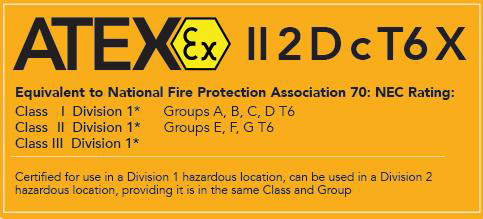
Explosion Proof and ATEX rated Vacuum Systems
In industrial settings where combustible dust poses a substantial safety hazard, specialized explosion proof vacuum systems play a pivotal role in ensuring workplace safety and efficient dust control. Three critical categories of vacuum systems—anti-static, explosion proof, and ATEX rated—and highlights their essential features include:
Anti-Static Vacuum Systems:
- Purpose: Anti-static vacuum systems are designed to eliminate the risk of static buildup, which can ignite combustible dust during the collection process.
- Key Features: These systems feature components and materials that dissipate static charges, preventing sparking or explosions. Conductive hoses, grounded attachments, and anti-static filters are commonly employed.
- Applications: Anti-static vacuum systems are versatile and are suitable for various industrial environments where dust is a concern. They are particularly beneficial in situations where Electrostatic discharge is a significant risk.
Explosion-Proof Vacuum Systems:
- Purpose: These explosion proof vacuum systems and explosion proof industrial vacuums are engineered to operate safely in potentially explosive atmospheres where combustible dust concentrations are prevalent.
- Key Features: Explosion proof vacuum systems and explosion proof industrial vacuums utilize non-sparking materials, sealed motors, and other safety measures to prevent ignition sources from contacting the collected dust. They are constructed to withstand the hazards of dust environments.
- ATEX Certification: Many explosion proof vacuum systems and explosion proof industrial vacuums adhere to ATEX directives, ensuring compliance with European standards for equipment used in explosive atmospheres.
ATEX Rated Vacuum Systems:
- Scope: ATEX-rated explosion proof vacuum systems comply with ATEX regulations, which are widely adopted in Europe and other regions. These systems are certified for safe operation in areas where explosive dust is present.
- Compliance: ATEX-rated explosion proof vacuum systems are designed to meet specific safety standards and categorization based on the likelihood of explosive atmospheres. Different zones are defined to classify the presence of combustible dust.
- Safety Measures: These explosion proof vacuum systems incorporate features to prevent sparking and static buildup, meeting the rigorous safety requirements outlined by ATEX directives.
Anti-static, explosion-proof, and ATEX rated vacuum systems and industrial vacuum cleaners are indispensable tools in industries facing the risks associated with combustible dust. Each category addresses Electrostatic discharge concerns, electrical equipment, potential ignition sources, and regional compliance standards. The choice of industrial vacuum cleaners and an explosion proof vacuum system depends on the specific needs and regulatory environment of the industrial setting.
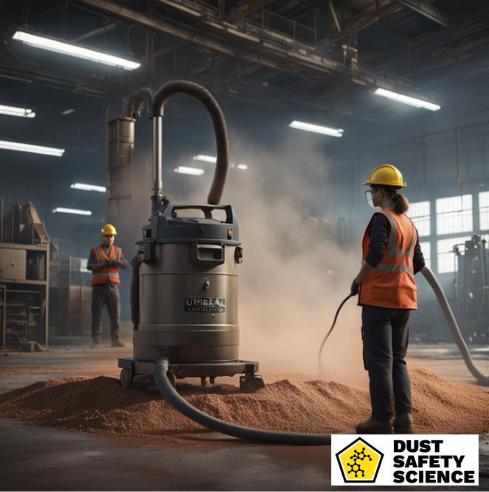
Best Practices for Combustible Dust Vacuums
- Regular Maintenance: Routine maintenance schedules include filter replacement, inspections, and ensuring all components are in optimal working condition to maintain efficiency and safety.
- Operator Training: Proper training on the use of explosion proof, combustible dust vacuum cleaners, and industrial vacuum cleaners is crucial. Operators should be educated on safety protocols, handling procedures, and equipment limitations to mitigate risks effectively.
- Risk Assessment and Prevention: An internal safety administration should be conducting regular risk assessments to identify areas prone to fugitive combustible dust accumulation is vital. Implementing preventive measures, such as frequent cleaning schedules using specialized vacuums, helps minimize the risk of dust-related incidents.
Conclusion
Explosion proof vacuums, and combustible dust vacuums are required in various industries. Preventing dust-related incidents, creating safer working environments, and managing combustible dust particles, combustible metals, dust fire threats, and dust explosion threats are extremely important. In addition, a certified, nationally recognized testing laboratory and proper certification to use the proper vacuum cleaners and industrial vacuum system is extremely important, in order to choose the right one. A vacuum cleaner and industrial vacuum systems must be Explosion-Proof, Anti-Static Vacuum Cleaners including hoses and tools, and ATEX Certified for use in National Fire Protection Association (NFPA) 70: NEC rating Class i, Division 1 (Zone 1 only), Groups A, B, C, D T6 and Class ii, Division 1, Groups E, F, G T6. OSHA-recommended housekeeping procedures are required for dust laden environments. Taking the first steps to comply with NFPA 652, as the NFPA 652 standard for managing combustible dust fire and explosion hazards, is extremely important. Complying with NFPA 652, allows a facility to operate more safely, in a dust laden environment.
Understanding combustible dust vacuums, including types of vacuums, and the devastating consequences of neglecting safety, is imperative. Various combustible dust vacuum strategies are presented, emphasizing the importance of proper housekeeping, system design, and preventive maintenance of fugitive dust. Explosion proof, combustible dust vacuums, as well as the benefits of using certified, anti-static, explosion proof vacuums, and ATEX-rated equipment, (example Class i), in high-risk combustible dust environments, are important in preventing dust hazards and explosion hazards.
About Dust Safety Science
For more from Dr. Chris Cloney on Combustible Dust Vacuums, visit this podcast episode: Certification of Portable Vacuum Systems for Use with Combustible Dust with Roger Guerra

Resources:
Visit Dust Safety Science (Global Incident Tracking)
Visit Dust Safety Academy (Resources, Training and Events)
Visit Dust Safety Professionals (Need Help? Get Support Today!)
Visit Dust Safety Journal for the Dust Safety Science Monthly Journal
Subscribe to our Dust Safety Science Newsletter at Dust Safety Science Newsletter
Visit the Dust Safety Science blog for written articles on combustible dust safety including the latest research, expert opinions, and state-of-the art in fire and explosion protection.
